You are here: Home » New Outlook » Features » Cover Story: Start a Fire
Cover Story: Start a Fire
By Erica Slutsky
What if therapy and recovery also encompassed exploring the wilderness, plus a deep connection to Jewish spirituality? BaMidbar Wilderness Therapy is doing just that, cultivating a safe, inclusive, and diverse environment for young people within the wider Jewish community.
Though a year-round program, BaMidbar Wilderness Therapy, located at Camp Ramah in the Rockies, involves the usual outdoor activities associated with wilderness programs, despite the stark differences in weather. On any given day, it could be hiking, spoon-making, or learning to start a fire without matches or a lighter – with ongoing group therapy sessions conducted in between. Families have the choice of their own therapy sessions via weekly phone calls with camp therapists, although parental involvement always differs among campers. A typical daily exercise will involve examining a rock, maybe a piece of quartz, or students writing an accountability letter to family members explaining their awareness of behavioral patterns, working through the process with a therapist, staff members, and the program’s other participants. Parents are often expected to continue the work and write a response. No hot food is served unless a campfire is scheduled for the day. A journal is provided to everyone, yet journaling is optional.
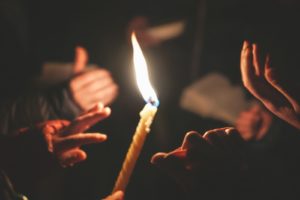
Listed among the traditional and sports-focused Ramah options, BaMidbar stands out. It is merely one Jewish program that emphasizes mental health and well-being among young people, but is the only Jewish program of its kind. Wilderness therapy, in practice, is supposed to offer a holistic supplement to traditional therapies for mental issues, ranging from low self-esteem and depression to bipolar and mood disorders. Though wilderness therapy programs for young adults are not a new phenomenon, since its recent inception in the mountains of Colorado, BaMidbar is creating an intentional growth space where its attendees can focus on individual needs and connect with their own spirituality, whatever form it may take. Equal parts physical and mental, BaMidbar was created recently, its initial programs running January through May and in October, with the current iteration running full-time. However, while the program is housed on a Ramah campus, the students ages 18-26 who attend have varying relationships with Judaism, including Conservative, Reform, Orthodox, and non-practicing. New Outlook spoke with BaMidbar’s largely female staff, a mixture of Jewish and therapeutic professionals, students, and Ramah alumni, all of whom have deep connections to Jewish life, about why BaMidbar provides an overlooked – and perhaps even essential – service to the Jewish community.
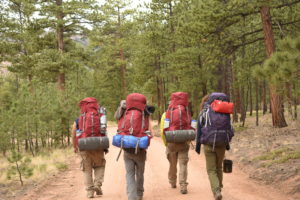
BaMidbar Director Jory Hanselman describes the program’s overall mission as “To guide Jewish young adults on journeys of self-discovery and healing through nature-based therapy.” Her first exposure to wilderness therapy happened when she attended a similar program in Utah at fifteen. After studying Philosophy and Environmental Science at Tufts University, she worked as a field guide and program manager in wilderness therapy, eventually teaching Native and Latinx youth wilderness skills with a nonprofit in New Mexico. Like those programs, BaMidbar aims to “[support] individuals in finding their best selves” and living longer, more productive, healthier lives. From her experience, she sees mental illness as a problem that affects communities regardless of race, religion, or class standing. The Jewish community, however, provides limited resources as far as dealing with serious mental illnesses. Hanselman encourages students to ask “big questions” and try to understand themselves within those communities, a major theme of Jewish life and text. “Our tradition is so rich with struggle, and stories of struggle, and stories of self-exploration.” She characterizes the transition from teenager to adult as being just as fraught, with many negative thought and behavioral patterns taking shape. Not every child or parent has the relevant skills and tools to cope with that change. To her, one of the bigger questions raised at BaMidbar is “How can we look at Judaism as something relevant and important that can help us in understanding who we are, what we value, and where we want to go in life, and how we face challenges?”
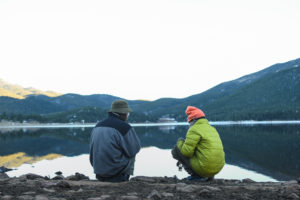
With that in mind, BaMidbar Wilderness Therapy began almost ten years ago, when Ramah in the Rockies Executive Director Rabbi Eliav Bock, a JTS graduate, noticed wilderness therapy programs and wondered how many of the students going to them were Jewish. Once he saw a need for a wilderness therapy program that further considered Jewish students who keep Kosher and observe Shabbat, Hanselman was the first Jewish outdoor professional he hired in 2016 to co-create it. A ten-page business plan and what Hanselman calls “a theory of change” were drafted over the next eighteen months as a separate program under the Ramah in the Rockies umbrella. Hanselman categorizes this approach as akin to other wilderness therapy programs, which offer “general outdoor behavioral healthcare,” unlike a traditional outdoor camp.
It’s difficult to attribute a single defining trait to BaMidbar’s freeform curriculum, although campers learning tasks through repetition, and creating a new mindset that they “can,” are two of its key foundations. Another big one has to do with a major part of Jewish culture and scripture: Metaphor. Danit Cohen, a former field guide and current Communications Assistant, describes the BaMidbar mission as to “support their ability to get back to a healthy, independent lifestyle” by combining nature-based activities and Jewish tradition. As a by-product of this work, the program’s facilitators aim to create conversation and diffuse the stigma of mental health, even after the experience ends. Because depression and low confidence are so prevalent within marginalized cultural and religious communities (and young people), they could easily be dismissed by family, friends, and colleagues – or seen as stigma. Rather, BaMidbar promotes open dialogue. The program kicks off with Shmirat Hanefesh (“care for the soul”) six days a week, a twenty-minute piece of reflection, which can take the form of a journal prompt, a silent meditation, a personal music choice, or identifying a negative pattern. Every student’s daily practice looks different: Of the students, 60% identify as Conservative or Orthodox. Everyone is expected to keep Kosher and observe Shabbat during treatment, but some may daven in the morning, and others might do some free writing (journaling is permitted on Shabbat). Time is spent hiking in the mountains, attending individual, group, and family therapy, and learning primitive skills. Typically, a “family weekend” is held on campus to involve parents in the “journey,” in addition to their optional phone calls to the camp therapist. Psychological testing provides another option, for an extra fee. By graduation, each group will have changed their thinking in some way, gained self-esteem, or learned a life skill, all tailored to each camper’s individual needs. “Building a foundation of self-understanding” through that skill-building, according to Hanselman, is the common thread linking all of them together. She sees this hoped-for behavior change as a way of stepping back and reflecting inward, comparable to the idea of a vision quest in Native American culture, although Jewish culture is significantly different.
Like similar wilderness programs, BaMidbar stresses body awareness, personal space, and developing a more confident inner voice through discussion, writing exercises, and positive reinforcement. Dogs are on site, and therapists arrive twice a week, though the main goal for the staff during students’ time on campus is helping the group feel a strong sense of accomplishment each day. That accomplishment could be, for example, campers hiking 10.7 miles, a challenge with so many bodies adjusting to the mountain altitude, some of them unused to the exercise. BaMidbar campers are dealing with problems ranging from substance abuse to “mild self-harm,” low self-esteem, and mood disorders, so the publicity materials are quick to emphasize that there is no one-size-fits-all solution. Emily Heeren, Field Director, started out as a Field Guide working 24/7 with students at varying levels of progress. She explains that BaMidbar is not an “end-all, be-all, fix-it” course of therapy. “Every opportunity is an opportunity to learn,” especially with so much individualized attention. As with most traditional and non-traditional therapies, and in Jewish culture, storytelling provides a large component of the treatment process: Middot, or character traits, are further emphasized daily through repetition, cards, and teachable lessons. There is also the use of Havdalah after Shabbat to transition into the work week as a shifting mindset from a relaxation state. After all, therapists often use understandable narratives to clarify what rehabilitation entails for their patients.
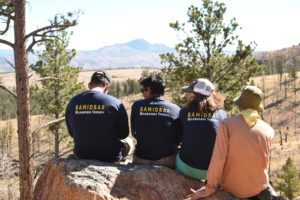
For its employees, BaMidbar is a unique, if not-dissimilar opportunity for professional growth. The guides have a say in the overall policies of the camp, as well as how its structure differs from more established wilderness programs, with a staff ratio of one staffer working with three students at each time. BaMidbar staffer Shoshana Trager describes the planning and practice of training, from which foods served are Kosher to programmatic implementation, as multi-layered. But BaMidbar doesn’t run on a rigid schedule, unlike most mental health programs, instead emphasizing a sense of self-dependency among its participants. Campers are already provided with clothing, sleeping bags, socks and shoes, a wood stove in the winter, and tipis for housing, among other essential provisions – they need only keep eyeglasses, tefillin, and tallit, since all other personal items, such as money and phones, are stored away during their time in the program. BaMidbar tries to help both its participants and leaders, which includes fostering confidence among the group.
One major talking point within the BaMidbar framework, intentional or not, is its gender parity and mostly woman-led staff, which is extremely rare in wilderness therapy, and in outdoor work in general. Hanselman cites the statistic that women benefit from having a mostly female staff in a therapeutic relationship – and that men benefit even more. Women in particular offer support and strong role models with experience, something that the campers find easy to trust when they are in a more relaxing environment and free of external stressors. Recently, a female guest rabbi was invited to the camp to lead services; for many male campers, who had attended predominantly male Hebrew schools and congregations, it was new. Part of that pluralistic space goes with the overall idea of not silencing women’s voices, especially given the specific mental health concerns that women face. The support system offering help year-round is often described by its facilitators as “a pool of strong women.” However, the majority of students in the program are still male; the visibility and inclusivity of the program extends to not letting gender affect anyone’s roles, or their perceptions of others, with wilderness itself being a historically male-dominated field. “The lack of women in the industry isn’t [due to a lack of women’s ability]” as much as it’s accidentally become a cultural norm due to varying factors. According to Cohen, “Having programs that have more women in them leads to other programs that have more women in them.” She also admits that it’s easy to write off “wilderness therapist” as a job because the profession isn’t especially widespread. Like other professionals in the camp, environmental, and adventure fields, wilderness guides at Bamidbar are trained in CPR, wilderness first aid, land navigation, and nonviolent crisis management, and they continue to receive weekly instructions on how to deal with all behavioral and medical emergencies, even after their pre-program training is finished. The more her colleagues hear about what Cohen does for a living, she says, the more intrigued they are about it.
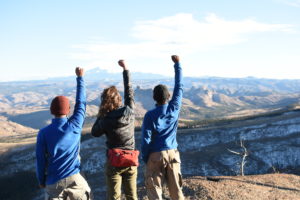
Can it go further? BaMidbar will continue its expansion and reach outside of the Ramah community. The program has already worked with BBYO and Solomon Schechter on developing integrated programs. One thing that isn’t a problem for BaMidbar is affordability: roughly 80% of its students attend on significant scholarships. Of the twenty-three currently operational wilderness therapy programs, BaMidbar is notable for being one of only two non-profits. As of this article’s publication, it will have just been voted as the newest member of the Outdoor Behavioral Healthcare Council, meaning that it has finally been accredited as an official wilderness therapy program. Future considerations, including equine therapy and farm- and service-oriented programs, have been discussed, and offering the program to younger adolescents in the coming years has also been mentioned. Hanselman adds that the program itself could become more experiential as it grows and develops. But for now, BaMidbar will try to adapt to the needs of its growing community, providing a more widespread presence for young Jewish people who are struggling, as well as for those who care about their life and well-being.
Learn more about BaMidbar Wilderness Therapy at www.BaMidbartherapy.org. Photos courtesy of BaMidbar Wilderness Therapy.
Listen to Jory Hanselman’s interview with The Jewish Hour on Spotify!
Listen on Stitcher:







